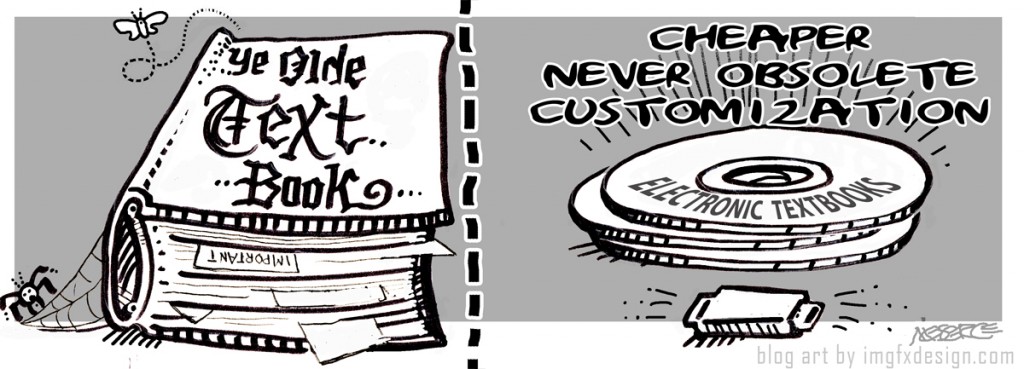
For many upper-level courses, it has often been difficult to find the right traditional textbook and until Electronic Textbooks (ETs) became an option, compromising has been commonplace. Professors have often been forced to choose between the lesser of two evils or assemble numerous articles and distribute a packet to each student. ETs are a terrific new alternative provided the right course parameters exist. This article will discuss:
- Advantages of ETs over traditional textbooks.
- Evaluation considerations in deciding when to utilize ETs
- Typical ET and potential obstacles
- Adherence to copyright laws for both faculty and students
Advantages of Electronic Textbooks Over Traditional Textbooks
Total Customization of Course Materials
It’s unusual to have win-win situations in life; however, ETs can create this. The professor is able to customize the exact materials to best meet their courses’ learning objectives while the student textbook costs are significantly lowered (often resulting in at least 50% savings; see below under More Cost Effective section.
I have built ETs with a combination of numerous chapters from leading textbooks along with both articles and cases from extensive online publishers. In addition to major publishers being known for their cases (i.e.: HBSP, Daren, Ivey), they often have excellent articles and traditional textbooks already in electronic format.
I have found most publishers allow ET providers to use up to approximately 10% of a textbook which translates usually into two chapters per textbook. The ET provider contacts the publisher for permission for the specified chapter(s) and receives a cost quotation. Logistically either the publisher provides the PDF to the ET provider, or you simply create a clean PDF of these specified chapters and forward it to the ET provider.
Addresses Traditional Textbooks Becoming Technically Obsolete
Many traditional textbooks, despite updated editions, can become technically obsolete very quickly with the rapid advancement in technology. An example of this is while teaching Marketing Management, topics like Social Media and Search Engine Optimization/Marketing are not mentioned or adequately covered in any available traditional textbooks I researched. ETs enable your course to be current with today’s technology even if it involves supplementing a quality traditional textbook with a few articles.
Additional Materials Can Be Added Throughout the Semester
My experience has been limited to one ET provider and they have been incredibly responsive and accommodating so I have had no reason to contact other providers. Adding any number of readings during the semester is very easy and can be done in a matter of days. Students initially pay for the access to the original course PDFs established at the outset of the semester. If the professor chooses, they can add PDFs at any time, whereby the students need only pay the ET provider online a small fee to have access to the new PDF files. See FREE Attachment illustration whereby my course Syllabus only had the assigned reading materials through Week 9 as I wanted to take more time to finalize the readings for the last portion of the course.
More Cost Effective
A traditional, new, bound textbook typically costs between $110 and $150 from a university bookstore. I have found that an ET typically runs about $60 to $90 which results in about a 50% savings (excluding the student’s cost to print out on paper). Articles and cases cost $5-$8; textbook chapters cost $8-$10. Overall costs can be brought down further as many university libraries subscribe to these same business publishers and therefore students have free access. University librarians are usually quite knowledgeable in locating an article, case or chapter from the multitude in their subscriptions. Professors then simply direct students to download the reading from their school library website for free, instead accessing in from the ET provider.
Other sources of excellent articles include associations that once contacted, usually allow distribution free. An example of this was finding a terrific article entitled, “Crisis Management and Communication” from the Institute of Public Relations for a hospitality class I teach.
Evaluation Considerations in Deciding When to Utilize Electronic Textbooks
I have taught courses where the use of a traditional textbook is far superior to an ET, and I have taught other courses where just the opposite applies. A traditional textbook is typically ideal for an introductory level course or higher level courses where content remains quite uniform over the years. Usually there are numerous options from major publishers readily available. Other advantages of a traditional textbook include: test banks, lecture guides, exercises, and short five to ten minute video segments introducing topics. Many times technology may only be impacting your course in a few topical areas and you can supplement the effective traditional textbook with a few readings purchased from the ET provider. An example of this is in teaching Marketing Management I supplement a solid textbook with PDFs on Social Media and Search Engine Optimization/Marketing.
ETs have great application when your topic is either an upper-level specialized course or technology is making traditional textbook options obsolete despite even new editions being released. An example of this was when I was teaching a specialized course in hospitality entitled, “Hospitality Quality and Service Management.” There was only one book written on the topic and I found the ET a much superior approach.
Typical Electronic Textbook Providers and Potential Obstacles
ET providers include Study.net, Harvard Business School Press, eText and major publishers such as McGraw Hill. Major publishers offering these services may require the ET to be printed and sold through the university bookstore which adds upfront lead time and doesn’t allow the ease of add-ons throughout the semester. These publishers also may limit you to their inventory of available cases and articles.
Adherence To Copyright Laws For Both Faculty and Students
Many professors and students are breaking copyright laws. Authors and publishers deserve to get compensated for their authorship, publishing and distribution efforts. Many professors take articles or chapters from textbooks and provide handouts to students whether or not they try to recover the copying costs from students. Copyright laws are being grossly violated. During my first year of teaching I asked an experienced professor within my department about appropriately adhering to copyright law in conjunction with my intent to copy and distribute articles and select textbook chapters. They responded, “Better to ask for forgiveness, than ask for permission.” The irony was that the faculty member was the sole attorney within the department teaching Business Law. Just like burning a copy of your favorite music group or movie, I don’t feel comfortable.
ETs solve this copyright infringement problem and thus compensate the publishers and authors involved. Each student goes online and usually pays with a credit card that enables them to download each of the separate PDFs whenever they choose. So what prohibits each student from not paying separately and only having select students pay and share access to PDFs? ET providers can generate a list of students that have paid for access. I require each student to obtain their own copy and my syllabus states: “Highly tailored readings or cases from textbooks, articles and publishers’ libraries have been developed cost effectively and are available on ETWebsite Name. Consistent with copyright laws, I will require full payment to ETWebsite Name for all reading materials assigned, consistent with the syllabus, prior to receiving back your tests and submitting your final grade.”
Propelling Forward the Use of Electronic Textbooks to Create Win-Win Situations
The right textbook makes such a difference in the effectiveness of the course for both students and the professor. Efforts should be heightened so that faculty are exposed to and have training available on ETs to increase their usage as either a supplement to a traditional textbook or as the entire textbook.
